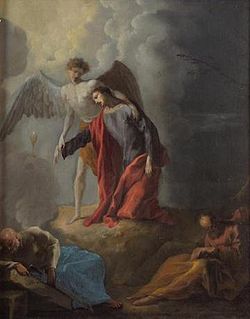- Matthew 28:4
-
Matthew 28:4 is the fourth verse of the twenty-eighth chapter of the Gospel of Matthew in the New Testament. This verse is part of the resurrection narrative. This verse describes the reaction of the tomb guards after the arrival of an angel and an earthquake that opened the tomb.
The original Koine Greek, according to Westcott and Hort, reads:
- απο δε του φοβου αυτου εσεισθησαν οι
- τηρουντες και εγενηθησαν ως νεκροι
In the King James Version of the Bible it is translated as:
- And for fear of him the keepers
- did shake, and became as dead men.
The modern World English Bible translates the passage as:
- For fear of him, the guards
- shook, and became like dead men.
For a collection of other versions see BibRef Matthew 28:4
This verse returns to the guards, literally "those keeping watch," who appear throughout the crucifixion narrative of Matthew but do not in any of the other gospels. This verse uses the same word for the guards as those at the crucifixion introduced at Matthew 27:36.[1] Those guards are also frightened by an earthquake at Matthew 27:54, but in that instance the guards are converted. These guards are fearful, but give no indication of conversion.[2] In Mark it is the women who are afraid of the angel. Matthew, who is accepted to have been working from Mark, transfers the line about fear from the women to the guards.[3]
To Gundry the weakness of the guards serves to contrast with the angel's power. That the guards are now as dead, while Jesus is alive also serves as an ironic reversal.[4] It is also something of a pun to have the guards tremble when confronted with an earthquake, perhaps reflecting the author of Matthew's fondness for wordplay.[5]
Falling like dead occurs again in the New Testament at Revelation 1:17, where the author does so when presented with his vision.[6] Similar expressions are also used in contemporary Greco-Roman pagan literature when mortals are confronted by gods.[7] Fear is also the standard reaction in the Bible when confronted by the divine, and this verse is a variation on the expression "fear and trembling" that commonly describes such incidents.[8]
The collapse of the guards removes them from the rest of this section of the narrative. Schweizer notes that the fainting of the guards and the possible absence of the women at this point indicates that Jesus may have emerged physically from the tomb during the period when no witnesses could have seen him.[9]
References
- ^ Nolland, John. The Gospel of Matthew: a commentary on the Greek text. Wm. B. Eerdmans Publishing, 2005 pg. 121248
- ^ Davies, W.D. and Dale C. Allison, Jr. A Critical and Exegetical Commentary on the Gospel According to Saint Matthew. Edinburgh : T. & T. Clark, 1988-1997. pg. 541
- ^ Nolland, John. The Gospel of Matthew: a commentary on the Greek text. Wm. B. Eerdmans Publishing, 2005 pg. 121248
- ^ Gundry, Robert H. Matthew a Commentary on his Literary and Theological Art. Grand Rapids: William B. Eerdmans Publishing Company, 1982. pg. 588
- ^ Nolland, John. The Gospel of Matthew: a commentary on the Greek text. Wm. B. Eerdmans Publishing, 2005 pg. 1247
- ^ Nolland, John. The Gospel of Matthew: a commentary on the Greek text. Wm. B. Eerdmans Publishing, 2005 pg. 1247
- ^ Keener, Craig S. The Gospel of Matthew: A Socio-Rhetorical Commentary. Wm. B. Eerdmans Publishing, 2009. pg. 701
- ^ Davies, W.D. and Dale C. Allison, Jr. A Critical and Exegetical Commentary on the Gospel According to Saint Matthew. Edinburgh : T. & T. Clark, 1988-1997. pg. 541
- ^ Schweizer, Eduard. The Good News According to Matthew. Atlanta: John Knox Press, 1975 pg. 524
Gospel of Matthew Preceded by:
Matthew 28:3Chapter 28 Followed by:
Matthew 28:5Categories:- Gospel of Matthew verses
Wikimedia Foundation. 2010.

